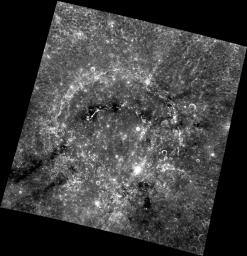This image features Mozart, an expansive crater just south of Caloris basin. Since this image was taken at a very high Sun angle (a low incidence angle), it emphasizes albedo contrasts, especially the dark streamers that can be seen extending away from the crater. During Mozart's formation low reflectance material was excavated from below the surface and ejected away from the impact site, producing the streamers.
This image was acquired as part of MDIS's high-resolution albedo base map. The best images for discerning variations in albedo, or brightness, on the surface are acquired when the Sun is overhead, so these images typically are taken with low incidence angles. The albedo base map is a major mapping campaign in MESSENGER's extended mission and will cover Mercury's surface at an average resolution of 200 meters/pixel.
Date acquired: June 15, 2012
Image Mission Elapsed Time (MET): 248259530
Image ID: 2020920
Instrument: Wide Angle Camera (WAC) of the Mercury Dual Imaging System (MDIS)
WAC filter: 7 (748 nanometers)
Center Latitude: 8.44°
Center Longitude: 170.1° E
Resolution: 348 meters/pixel
Scale: Mozart crater is approximately 240 km (150 mi.) in diameter.
Incidence Angle: 8.6°
Emission Angle: 19.3°
Phase Angle: 28.0°
The MESSENGER spacecraft is the first ever to orbit the planet Mercury, and the spacecraft's seven scientific instruments and radio science investigation are unraveling the history and evolution of the Solar System's innermost planet. Visit the Why Mercury? section of this website to learn more about the key science questions that the MESSENGER mission is addressing. During the one-year primary mission, MDIS acquired 88,746 images and extensive other data sets. MESSENGER is now in a year-long extended mission, during which plans call for the acquisition of more than 80,000 additional images to support MESSENGER's science goals.
These images are from MESSENGER, a NASA Discovery mission to conduct the first orbital study of the innermost planet, Mercury. For information regarding the use of images, see the MESSENGER image use policy.

 Planetary Data System
Planetary Data System












